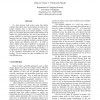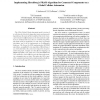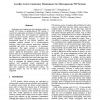IPPS
2007
IEEE
14 years 6 months ago
2007
IEEE
Graphs capture the essential elements of many problems broadly defined as searching or categorizing. With the rapid increase of data volumes from sensors, many application discipl...
IPPS
2007
IEEE
14 years 6 months ago
2007
IEEE
HPC scientific computational models are notoriously difficult to develop, debug, and maintain. The reasons for this are multifaceted — including difficulty of parallel programm...
IPPS
2007
IEEE
14 years 6 months ago
2007
IEEE
OpenMP has gained wide popularity as an API for parallel programming on shared memory and distributed shared memory platforms. It is also a promising candidate to exploit the emer...
IPPS
2007
IEEE
14 years 6 months ago
2007
IEEE
In a data intensive Grid system, many data replica schemes and models have been proposed to improve the system response time or data consistency, but little attention has been pai...
IPPS
2007
IEEE
14 years 6 months ago
2007
IEEE
The GCA (Global Cellular Automata) model consists of a collection of cells which change their states synchronously depending on the states of their neighbors like in the classical...
IPPS
2007
IEEE
14 years 6 months ago
2007
IEEE
Model checking, logging, debugging, and checkpointing/recovery are great tools to identify bugs in small sequential programs. The direct application of these techniques to the dom...
IPPS
2007
IEEE
14 years 6 months ago
2007
IEEE
In this paper we present a software tool for the simulation of distributed real-time embedded systems. Our tool is based on the popular NS-2 package for simulating the networking ...
IPPS
2007
IEEE
14 years 6 months ago
2007
IEEE
Replication and caching have been deployed widely in current P2P systems. In update-allowed P2P systems, a consistency maintenance mechanism is strongly demanded. Several solution...
IPPS
2007
IEEE
14 years 6 months ago
2007
IEEE
In the general area of high-performance computing, object-oriented methods have gone largely unnoticed. In contrast, the Computational Neighborhood (CN), a framework for parallel ...
IPPS
2007
IEEE
14 years 6 months ago
2007
IEEE
With the increasing gap between processor speed and memory latency, the performance of data-dominated programs are becoming more reliant on fast data access, which can be improved...






